This article details the working principles and classifications of circuit breakers to help you make more informed decisions when selecting and using these devices. Whether it is a Miniature Circuit Breaker or a Circuit Breaker for large power systems, this article will provide you with a valuable reference.
1. What is the basic principle of a Circuit Breaker?
Circuit Breaker is an automatic electrical switch. Its basic principle is to safely and reliably turn on and off the circuit when needed to maintain the normal operation of the power system and protect equipment from overload, short circuit, and other faults. Different types of circuit breakers may use different arc extinguishing technologies and operating mechanisms to meet the requirements of specific applications.
2. What criteria can be used for classification?
- According to the operation mode : electric operation, energy storage operation and manual operation;
- According to the structure : there are universal type and plastic shell type;
- According to the category of use : selective and non-selective;
- According to the arc extinguishing medium: there are oil immersion type, vacuum type and air type;
- According to the speed of action : there are fast type and ordinary type;
- According to the number of poles: there are monopolar, dipole, tripole and quadrupole;
- According to the installation method: there are plug-in, fixed and drawer type;
- Classified by voltage level: respectively, low voltage circuit breaker (LV), high voltage circuit breaker ( HV ).
- After understanding the above classification criteria, we will now introduce six common Circuit Breakers that cover the above criteria.
3. What are the common circuit breakers on the market?
3.1 Miniature Circuit Breaker
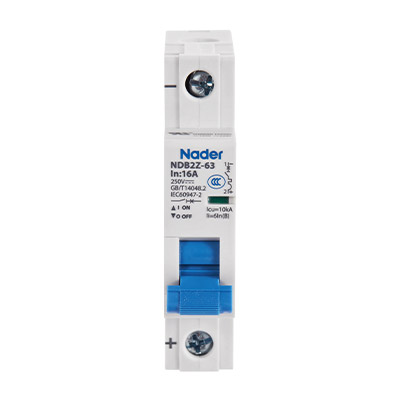
The working principle of a miniature circuit breaker is based on the need to protect the circuit from overload and short circuit. It can detect these conditions and automatically cut off the current to prevent overheating of wires and possible fires.
3.1.1 Working principle of miniature circuit breaker
1. Overload protection:- When the current flowing through the MCB exceeds its rated value, overload occurs. In this case, the current flowing through will cause the bimetallic sheet inside the circuit breaker to overheat.
- The bimetallic sheet is made of two different metals, each with a different coefficient of thermal expansion. When the bimetallic sheet bends due to overheating, it triggers a mechanical mechanism that causes the circuit breaker to trip, thus cutting off the circuit.
- This process may take some time because the bimetallic sheet needs time to respond to overload conditions.
- During a short circuit, the current in the circuit increases rapidly to a very high level. The electromagnetic coil inside the MCB is very sensitive to this sudden increase in current.
- When the current exceeds a certain safety threshold, a strong magnetic field is generated by the large current passing through the electromagnetic coil, which quickly attracts an iron core and activates the mechanical release mechanism of the circuit breaker.
- This causes the circuit breaker to trip immediately, cutting off the circuit, thus protecting the wires and equipment from damage.
- MCB also allows manual control, that is, users can manually turn on or off the circuit. When MCB trips due to overload or short circuit, it can be manually reset after the problem is resolved.
- Many MBCs are equipped with indicator devices to display their status (connected or disconnected).
3.1.2 Current and voltage range of micro circuit breakers
1. Current range:- Miniature circuit breakers are commonly used for lower current ranges, which typically range from a few amperes (A) to tens of amperes. For example, common MCB current grades in residential and commercial buildings may include 6A, 10A, 16A, 20A, 32A, 40A, 50A, etc.
- The choice of current level depends on the design load and electrical safety requirements of the circuit. Different current levels are suitable for different purposes, such as lighting circuits, socket circuits, and high-power equipment circuits.
- Miniature circuit breakers are usually designed for standard residential and commercial voltages, which are generally in the range of 100-240 volts (V) alternating current (AC) . In some countries and regions, the standard voltage may be 110V or 120V, while in other regions it may be 220V or 230V.
- For industrial applications, MCBs may also be designed for higher voltages, but still within the general low voltage range, such as 415V or 440V.
3.1.3 The main components of a miniature circuit breaker include
- Terminal blocks : used to connect circuit lines. There are usually two terminals, one for the input end (i.e. power supply line), and the other for the output end (i.e. load line).
- Touchpoint : includes fixed touchpoint and active touchpoint, which close during normal operation and allow current to pass. When the circuit breaker trips, the touchpoint separates and cuts off the circuit.
- Bimetallic sheet : Used for overload protection. Bimetallic sheet is made of two metals with different thermal expansion coefficients. When the current flowing through exceeds the rated value, the metal sheet bends due to heat, driving the mechanical mechanism to trip the circuit breaker.
- Electromagnetic coil : used for short circuit protection. In the case of a short circuit, the current through the coil increases sharply, and the magnetic field strength generated is sufficient to trigger the mechanical mechanism to make the circuit breaker trip quickly.
- Mechanical switch mechanism : When the bimetallic sheet is bent or the electromagnetic coil is activated, the mechanical switch mechanism will act to separate the touchpoint and cut off the circuit.
- Spring system : During trip operation, the spring system helps to quickly separate the touchpoint, ensuring that the circuit breaks down quickly.
- Manual operation mechanism : used to manually open or close the circuit breaker. Under normal circumstances, the operator can use this mechanism to control the circuit on and off.
- Indicating device : Some models of miniature circuit breakers have an indicating device to show the status of the circuit breaker (whether it is connected or tripped).
3.1.4 The main application scenarios of miniature circuit breakers
- Household electrical protection : Miniature circuit breakers are used in household circuit boards to protect lighting, sockets and household appliances, and control the end point equipment circuit of each household.
- Commercial buildings : In commercial buildings such as work buildings, shopping centers, schools, hospitals, etc., miniature circuit breakers are used to protect electrical equipment and lighting systems at the end point.
- Industrial control systems : Miniature circuit breakers are used in industrial environments to protect electric motors, control panels, and other end point industrial equipment.
- Renewable Energy Systems : In solar and wind power systems, miniature circuit breakers are used to protect end-point electrical equipment from voltage fluctuations and overloads.
3.2 Molded Case Circuit Breaker
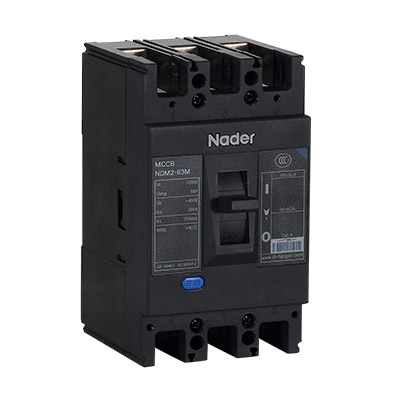
The molded case circuit breaker is a protective device for high current circuits. Its working principle is based on detecting and responding to overload and short circuit conditions in the circuit.
3.2.1 Detailed working principle of molded case circuit breaker
1. Overload protection:- When the current in the circuit exceeds the set safety limit, overload occurs. The bimetallic sheet in the MCCB is used to detect this situation.
- The bimetallic sheet will gradually heat up under the action of overload current. Due to the different composition of metals, the thermal expansion rate of metals is different, and bending will occur during heating.
- When the bending reaches a certain degree, the mechanical release mechanism is triggered, causing the touchpoint of the MCCB to separate, thus cutting off the circuit.
- During a short circuit, the current in the circuit rapidly increases to a very high level. The electromagnetic coil inside the MCCB is very sensitive to this sharp increase in current.
- When the current exceeds a certain threshold, the magnetic field generated by the coil is strong enough to quickly trigger the mechanical release mechanism, causing the touchpoint of the MCCB to immediately separate and disconnect the circuit.
- The molded case circuit breaker also allows users to operate manually, opening or closing the circuit manually. This feature allows the operator to control the circuit's on/off and reset the circuit breaker after tripping.
- When the touchpoint separates, an arc is generated. The MCCB has a specially designed arc extinguishing system inside (usually including an arc baffle or arc extinguishing chamber) to quickly extinguish the arc and prevent it from damaging equipment or causing a fire.
- Many MCCBs allow users to adjust the triggering current of overload protection, which allows MCCBs to be customized and adjusted according to specific application needs.
3.2.2 Current and voltage application range of molded case circuit breaker
6. Current range:- The current range of MCCB usually ranges from tens of amperes (A) to thousands of amperes. Typical current levels may include 100A, 250A, 400A, 630A, 800A, or even higher.
- This makes the MCCB suitable for large industrial facilities, commercial buildings, or any application that requires handling high currents.
- The voltage level of MCCB usually covers the low to medium voltage range, generally between 240V and 600V, and may even be as high as 1000V.
- This voltage level is suitable for most commercial and industrial power systems, including three-phase power supply systems.
3.2.3 The main components of a molded case circuit breaker include
- 1. Enclosure : Usually made of strong insulating material (such as plastic), used to encapsulate and protect internal components.
- 2. Touchpoint : includes fixed touchpoint and action touchpoint. Under normal circumstances, the touchpoint is closed, allowing current to pass through. When the circuit breaker trips, the touchpoint separates and cuts off the circuit.
- 3. Bimetallic sheet : used for overload protection. The bimetallic sheet heats up and bends when the overload current passes through, triggering the open circuit mechanism.
- 4. Electromagnetic coil : When the circuit is short-circuited, the magnetic field generated by the large current through the coil quickly triggers the open circuit mechanism.
- 5. Mechanical operating mechanism : Allows manual opening or closing of the circuit breaker and drives touchpoint separation when the circuit breaker automatically trips.
- 6. Spring system : When the circuit breaker trips, the spring system helps to quickly separate the touchpoint, ensuring that the circuit is quickly disconnected.
- 7. Trip unit : contains bimetallic sheet and solenoid, responsible for detecting overload and short circuit conditions in the circuit and triggering open circuit.
- 8. Auxiliary components : such as auxiliary touchpoints, alarm touchpoints, circuit breaker status indicators, etc., used to provide additional monitoring and control functions.
- 9. Arc extinguishing system : When the touchpoint is separated, it is used to quickly extinguish the arc to prevent the arc from damaging the equipment or causing a fire.
3.2.4 The main application scenarios of molded case circuit breakers
- Industrial applications: Moulded case circuit breakers are very common in industrial environments and are usually used for main distribution boards and distribution boards to undertake the circuit delivery of frame circuit breakers .
- Commercial buildings: In commercial buildings such as work buildings, shopping malls, hotels and schools, molded case circuit breakers are used in distribution meters to protect the equipment circuits on each floor.
- Data centers and telecommunications facilities: Data centers and telecommunications infrastructure require stable and reliable power. Molded case circuit breakers are used in these applications to protect sensitive equipment such as servers, communications equipment, and UPS systems.
- Energy management and power generation: In power stations and renewable energy systems such as solar and wind power, molded case circuit breakers are used to protect power generation equipment and power transmission lines.
- High-end residential applications: In some high-end residential or large residential buildings, due to the high demand for electricity, molded case circuit breakers can be used for the protection of the main power inlet and large household appliances (such as central air conditioning systems).
- Distribution centers and substations: In power distribution centers and substations, molded case circuit breakers are used to control and protect high current circuits.
- Ships and heavy machinery: In ships and some mobile equipment (such as large construction machinery), molded case circuit breakers will be used to protect the electrical system from overload and short circuit damage.
3.3 Frame Circuit Breaker
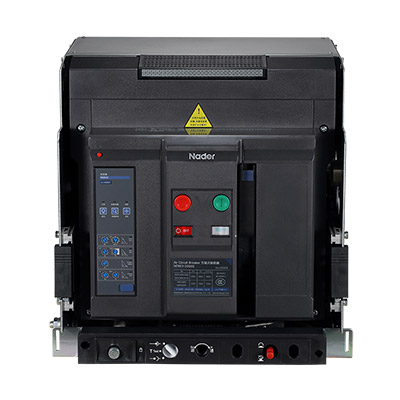
Also known as Universal Circuit Breaker, Air Circuit Breaker, is a protective device for high current and high voltage circuits, usually used in industrial and large commercial power systems.
3.3.1 Detailed working principle of frame circuit breaker
1. Arc extinguishing mechanism:- When the ACB detects a fault and trips, the touchpoints separate, resulting in an arc between the touchpoints.
- The arc extinguishing system in ACB is designed to quickly extinguish this type of arc. It achieves this by forming multiple small arcs between touchpoints and rapidly cooling them, thereby preventing equipment damage or fire caused by the arcs.
- The thermal protection mechanism in ACB is usually composed of bimetallic sheets, which will heat up and bend under the action of overload current.
- When the bimetallic sheet is bent to a certain extent, it triggers the mechanical switch mechanism, causing the ACB to trip, thus cutting off the circuit.
- During a short circuit, the current rises sharply. The electromagnetic coil in ACB generates a strong magnetic field under the action of the short circuit current, which quickly triggers the circuit breaker to trip.
- This rapid response mechanism ensures that the circuit is quickly disconnected in the moment of a short circuit, preventing serious damage and fire risks.
- Users can manually operate the ACB to turn on or off the circuit. This feature is particularly important during maintenance or inspection.
- Modern ACBs are typically equipped with remote control and monitoring capabilities, allowing operators to remotely operate circuit breakers and monitor their status.
- Many ACBs also offer additional features such as overvoltage protection and ground fault detection.
3.3.2 Current and voltage range of the frame circuit breaker
- 1. Current Range: ACB currents typically range from a few hundred amperes (A) to several thousand amperes. Typical current grades may include 400A, 630A, 800A, 1000A, 1600A, 2000A, or even higher.
- 2. Voltage range: ACB is commonly used in medium and high voltage circuits, and the voltage level can be from 400V, 690V to 1000V or even higher.
3.3.3 The main components of a frame circuit breaker include
- 1. Enclosures and Frames: Provides structural support and protects internal components. Usually made of strong insulation, sometimes the enclosure may contain metal parts to provide additional strength and durability.
- 2. Touchpoint system: including fixed touchpoint and action touchpoint. Under normal circumstances, the touchpoint is closed, allowing current to pass through. When the circuit breaker trips, the touchpoint separates and cuts off the circuit.
- 3. Arc Extinguishing System: When the touchpoint separates, an arc is generated. The arc extinguishing system extinguishes it by rapidly cooling and dispersing the arc, preventing it from damaging equipment or causing a fire.
- 4. Operating mechanism: used to manually or automatically open and close circuit breakers. The operating mechanism can be mechanical or electric.
- 5. Control Unit: Contains electronic components for monitoring circuit conditions and controlling circuit breaker operation. The Control Unit may include microprocessors and sensors to provide precise protection and monitoring functions.
- 6. Overload protection device: Usually a bimetallic sheet used to detect overload conditions. When the current exceeds a predetermined value, the bimetallic sheet heats up and bends, triggering the circuit breaker to trip.
- 7. Short circuit protection devices: including electromagnetic coils or electronic sensors, used to detect short circuits. In the event of a short circuit, these devices quickly activate the open circuit mechanism.
- 8. Auxiliary touchpoint: Other auxiliary devices used to control circuit breakers, such as alarms, indicator lights, or remote control systems.
- 9. Circuit Breaker Release Device: Responsible for activating the trip mechanism of the circuit breaker when a fault is detected. The release device may be based on thermal effects, magnetic effects, or more complex electronic protection logic.
3.3.4 The main application scenarios of frame circuit breakers
1. Industrial applications:- Frame circuit breakers are commonly used in the main switchboards of industrial facilities.
- In automated production lines, large machines, and manufacturing plants, frame circuit breakers are used to manage and protect high-current circuits.
- Commercial facilities such as shopping malls, work buildings, and hotels use frame circuit breakers to protect the high-current power systems of each building.
- In a data center, frame circuit breakers are used to protect overall servers and network equipment from power failures.
- Frame circuit breakers are used at the head end of power transmission and distribution networks, including substations and distribution stations, to protect the grid from faults.
- In thermal, hydraulic, nuclear, or renewable energy power plants, frame circuit breakers are used to control and protect high-voltage power equipment.
- Frame circuit breakers are also used in the power systems of ships and offshore oil drilling platforms to protect equipment from the harsh conditions in the marine environment.
- Electrical systems in large infrastructure projects such as subways, airports, bridges, and tunnels also use frame circuit breakers.
3.4 Vacuum Circuit Breaker
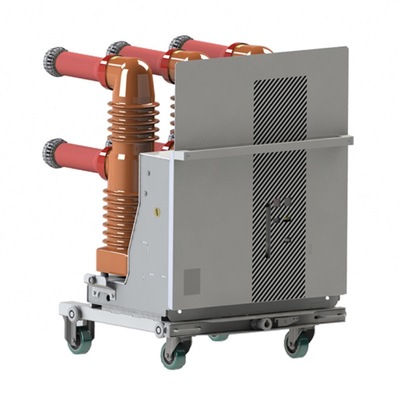
Vacuum circuit breakers use vacuum as the arc extinguishing medium and are suitable for medium current and medium voltage applications.
3.4.1 Detailed working principle of vacuum circuit breaker
1. Closed operation:- When the circuit breaker needs to be closed to establish a circuit connection, the spring operating mechanism is activated, pushing the movable contact to move towards the fixed contact.
- When the movable contact contacts the fixed contact, current begins to form a closed circuit through the two contacts.
- During the closing process, the current continues to flow through the vacuum chamber.
- When it is necessary to disconnect the circuit, the control system triggers the spring operating mechanism to quickly separate the moving contact.
- At the moment of separation, the current will generate an arc. At this time, the role of the vacuum chamber becomes critical because it extinguishes the arc by disconnecting the circuit in the vacuum.
- The vacuum chamber of a vacuum circuit breaker usually contains two main parts: an insulating container between the moving contact and the fixed contact. When the moving contact is separated, an arc is formed inside the insulating container.
- Due to the lack of gas in the vacuum, the arc cannot continue to exist, so it will be extinguished in a very short time.
- Arc extinguishing is achieved by creating a local electric field in a vacuum to spread the arc, causing the current to decrease to zero.
- The design of the vacuum chamber and the selection of arc-extinguishing materials have an important impact on the performance and reliability of the vacuum circuit breaker.
3.4.2 Current and voltage application range of vacuum circuit breaker
1. Current range:- Low current applications: low current applications ranging from a few hundred amperes (A) to below one thousand amperes.
- Medium current applications: medium current applications ranging from one thousand amperes to several thousand amperes.
- High current applications: high current applications ranging from several thousand amperes to tens of thousands of amperes.
- Low voltage applications: low voltage applications below several thousand volts.
- Medium voltage applications: medium voltage applications ranging from thousands of volts to tens of thousands of volts.
- High voltage applications: high voltage applications ranging from tens of thousands of volts to tens of thousands of volts.
3.4.3 The main components of a vacuum circuit breaker include
- 1. Fixed contacts: Fixed contacts are the stationary parts connected to the circuit, usually made of strong materials that can withstand current and mechanical stress.
- 2. Moving contact: Moving contact is a contact connected to a movable part, usually made of conductive material. The gap between it and the fixed contact forms a circuit when the circuit breaker is closed, and produces an arc extinguishing process when it is disconnected.
- 3. Vacuum Chamber: The vacuum chamber is a key component of a vacuum circuit breaker, used to produce an arc-extinguishing effect when the current is disconnected. It includes an insulating container between two contacts, and the vacuum inside the container is used to extinguish the arc. When the current is interrupted, the vacuum chamber prevents the arc from continuing to exist, ensuring reliable circuit disconnection.
- 4. Spring operating mechanism: The spring operating mechanism is used to control the opening and closing operation of the circuit breaker. Usually, the spring is responsible for pushing the movable contact when the circuit breaker needs to quickly disconnect the circuit to achieve the opening and closing operation.
- 5. Control and protection equipment: These devices include sensors for monitoring current, voltage, and other parameters, as well as electronic components for controlling and protecting circuit breakers. They ensure that the circuit breaker can respond appropriately in the event of a fault or overload.
- 6. Housing: The housing is the external protective structure of the vacuum circuit breaker, which is used to prevent dust, moisture and other environmental conditions from affecting the circuit breaker.
3.4.4 The main application scenarios of vacuum circuit breakers
- 1. High-voltage transmission system: used to protect and control high-voltage transmission lines to ensure the stable operation of the power system.
- 2. Substation: In substations, vacuum circuit breakers are used to open or close circuits for equipment maintenance, overhaul and switching.
- 3. Industrial Power Systems: In the industrial sector, vacuum circuit breakers are widely used in various power systems, including factories, mines, and other industrial facilities.
- 4. Railway electrification system: used in railway systems to ensure the safety and reliability of the power system.
- 5. Electric power plant: equipment used to connect generators, disconnect faulty circuits, and protect power plants.
- 6. Electrical equipment and mechanical equipment: In various electrical equipment and mechanical equipment, vacuum circuit breakers can be used to protect circuits from faults such as overload and short circuits.
- 7. Residential and commercial buildings: Used in small power systems, such as distribution boards in residential and commercial buildings.
- 8. Wind and solar power plants: In the field of Renewable Energy, vacuum circuit breakers are used to connect and protect the electrical systems of wind and solar power plants.
3.5 SF6 Circuit Breaker
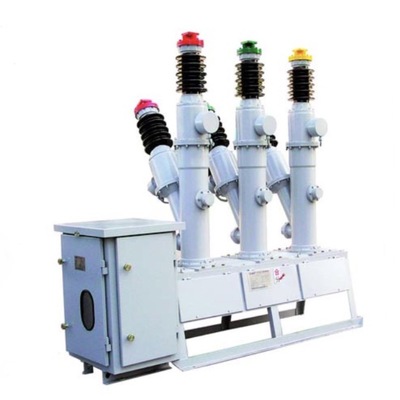
SF6 circuit breakers use sulfur hexafluoride gas as the arc extinguishing medium and are suitable for high-voltage and ultra-high-voltage power systems.
3.5.1 Detailed working principle of SF6 circuit breaker
1. Closed operation:- When a circuit connection needs to be established, the closing operation of the SF6 circuit breaker is to push the movable contact towards the fixed contact through the driving mechanism.
- At the moment of closure, current begins to form a circuit through the closed contacts.
- When it is necessary to disconnect the circuit, the SF6 circuit breaker triggers the spring mechanism through the control system, causing the moving contacts to quickly separate.
- At the moment of separation, the current will form an arc.
- The key component of the SF6 circuit breaker is sulfur hexafluoride gas, which provides highly reliable arc extinguishing performance when the arc is generated.
- The arc is formed in SF6 gas, but due to the special properties of SF6 gas, the arc is quickly extinguished. SF6 has good insulation properties, and after the arc is extinguished, the gas is not easily ionized, thus preventing the arc from forming again.
- During the arc extinguishing process, SF6 molecules absorb and rearrange electrons to form a highly stable molecular structure, thus preventing the continuation of the arc.
3.5.2 Current and voltage range of SF6 circuit breaker
1. Current range:- Low current applications: Low current applications from hundreds of amperes (A) to below one thousand amperes.
- Medium current applications: medium current applications ranging from one thousand amperes to several thousand amperes.
- High current applications: high current applications ranging from several thousand amperes to tens of thousands of amperes.
- Low voltage applications: low voltage applications below several thousand volts.
- Medium voltage applications: medium voltage applications ranging from thousands of volts to tens of thousands of volts.
- High voltage applications: high voltage applications ranging from tens of thousands of volts to tens of thousands of volts.
3.5.3 The main components of SF6 circuit breakers include
- 1. Circuit breaker body: The main body of the circuit breaker is the outer shell of the SF6 circuit breaker, usually made of metal, used to accommodate SF6 gas and other internal components. It has good insulation and sealing properties to ensure that SF6 gas does not leak and prevent the external environment from affecting the circuit breaker.
- 2. Fixed contacts: Fixed contacts are the stationary parts connected to the circuit, usually made of strong materials that can withstand current and mechanical stress.
- 3. Moving contact: Moving contact is a contact connected to a movable part, usually made of conductive material. The gap between it and the fixed contact forms a circuit when the circuit breaker is closed, and produces an arc extinguishing process when it is disconnected.
- 4. SF6 gas: SF6 gas is the working medium of SF6 circuit breaker, which is used to form arc and extinguish arc during the closing and opening process of circuit breaker. SF6 gas has good insulation performance and arc extinguishing characteristics.
- 5. Spring Operating Mechanism: The spring operating mechanism is used to control the closing and opening operation of the circuit breaker. It provides fast opening action by storing energy springs.
- 6. Arc extinguishing chamber: The arc extinguishing chamber is a key part of the SF6 circuit breaker, used to accommodate and extinguish the arc. When the arc is formed, the arc extinguishing chamber accelerates the cooling and extinguishing process of the arc by providing suitable conditions.
- 7. Control and protection equipment: These devices include sensors for monitoring current, voltage, and other parameters, as well as electronic components for controlling and protecting circuit breakers. They ensure that the circuit breaker can respond appropriately in the event of a fault or overload.
- 8. Pressure relief device: Since the SF6 gas in the SF6 circuit breaker may experience pressure changes during operation, the pressure relief device is used to release excess gas to maintain the appropriate working pressure.
3.5.4 The main application scenarios of SF6 circuit breakers
- 1. Power transmission system: In high voltage transmission networks, SF6 circuit breakers are used to open or close circuits to ensure the reliable operation of the power system. They are usually used in substations and power transmission lines.
- 2. Substations: SF6 circuit breakers play an important role in substations for connecting, disconnecting and protecting equipment within substations, such as transformers and cables.
- 3. Electric power plants: In power plants, SF6 circuit breakers are used to connect generators, disconnect faulty circuits, and protect power plant equipment.
- 4. Industrial Power Systems: In the industrial sector, SF6 circuit breakers are widely used in various high voltage power systems, including factories, mines, and other industrial facilities.
- 5. Railway electrification system: SF6 circuit breakers are used to protect the railway electrification system and ensure the safety and reliability of the power system.
- 6. High voltage laboratory: Because SF6 circuit breakers have excellent arc extinguishing performance, they are also commonly used in high voltage laboratories and research institutions for testing and researching high voltage electrical equipment.
- 7. Wind and solar power plants: In the field of Renewable Energy, SF6 circuit breakers are used to connect and protect the electrical systems of wind and solar power plants.
- 8. High voltage industrial applications: SF6 circuit breakers may also play a role in some special industrial applications that require high voltages and large currents.
3.6 Oil immersed Circuit Breaker
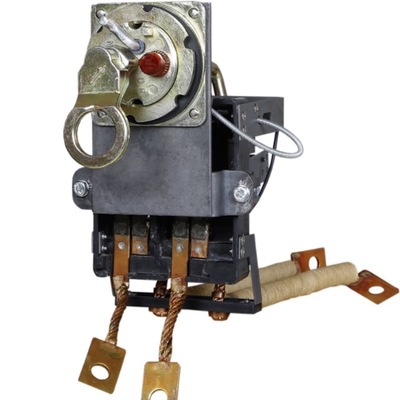
Oil-immersed circuit breaker is a common type of circuit breaker in power systems, mainly used for high voltage and high current applications, such as substations and power transmission lines. Its working principle involves basic operations such as circuit breaker closure, disconnection, and arc extinguishing.
3.6.1 Detailed working principle of oil-immersed circuit breaker
1. Closed operation:- When a circuit connection needs to be established, the spring operating mechanism is activated, pushing the movable contact towards the fixed contact.
- At the moment of closure, current begins to form a circuit through the closed contacts.
- When the circuit needs to be disconnected, the control system triggers the spring mechanism to quickly separate the moving contacts.
- At the moment of separation, the current generates an arc.
- After the arc is generated, the key part of the oil-immersed circuit breaker is the insulating oil. The arc enters the insulating oil, and the special properties of the oil help to achieve arc extinction.
- Insulating oil has high dielectric strength and can form an insulating sleeve in the arc to prevent further diffusion of the arc.
- At the same time, the bubbles, hot gases, and gas gaps in the insulating oil help cool the arc and accelerate the arc extinguishing process.
- During the arc extinguishing process, the current gradually decreases, eventually extinguishing the arc completely.
- The design of oil-immersed circuit breakers takes into account the importance of insulation and cooling. Insulating oil is used for both arc extinguishing and electrical insulation of contacts and other components.
- Insulating oil also has a cooling function, which can effectively cool the heat generated by the circuit breaker during operation.
3.6.2 Current and voltage range of oil-immersed circuit breakers
1. Current range:- Medium current applications: medium current applications ranging from thousands of amperes (A) to tens of thousands of amperes.
- High current applications: high current applications above tens of thousands of amperes.
- Medium voltage applications: medium voltage applications ranging from thousands of volts (kV) to tens of thousands of volts.
- High voltage applications: high voltage applications ranging from tens of thousands of volts to tens of thousands of volts.
3.6.3 The main components of an oil-immersed circuit breaker include:
- 1. Circuit Breaker Body: The circuit breaker body is the outer shell of an oil-immersed circuit breaker, usually made of metal, used to contain insulating oil and other internal components. It provides external protection for electrical equipment and ensures that the equipment can operate safely during operation.
- 2. Insulating oil: Insulating oil is a key part of oil-immersed circuit breakers, used to provide insulation and cooling of electrical equipment. It also plays an important role in the arc extinguishing process, by providing suitable conditions to prevent the spread of the arc and accelerate the extinguishing of the arc.
- 3. Contact System: The contact system includes moving contacts and fixed contacts, which are used to form a circuit when closed and generate an arc when disconnected. These contacts are usually made of conductive materials and can withstand high currents and temperatures.
- 4. Spring Operating Mechanism: The spring operating mechanism is used to achieve the closing and opening operation of the circuit breaker. It provides a fast opening action by storing energy springs, ensuring that the equipment can respond quickly and reliably.
- 5. Arc extinguishing chamber: The arc extinguishing chamber is a part of the oil-immersed circuit breaker used to accommodate and extinguish the arc. When the arc is generated, the arc extinguishing chamber accelerates the cooling and extinguishing of the arc by providing suitable conditions.
- 6. Insulation sleeve: The insulation sleeve is part of the insulation oil, used to form an insulation sleeve during the arc extinguishing process to prevent the spread of the arc.
- 7. Oil pump and circulation system : used to maintain the circulation of insulating oil, ensure that the oil-immersed circuit breaker can maintain the appropriate oil temperature during operation, and effectively cool the equipment.
- 8. Control and protection equipment: Control and protection equipment includes sensors, relays, and other electronic components that monitor current, voltage, and equipment status, and trigger corresponding protective actions when necessary.
3.6.4 Main application scenarios of oil-immersed circuit breakers:
- 1. Substation: Oil immersed circuit breakers are commonly used in substations to connect, disconnect and protect transformers, cables and other high voltage electrical equipment.
- 2. Power transmission system: In high-voltage power transmission lines, oil-immersed circuit breakers are used to protect and control the current to ensure the safe operation of the power grid.
- 3. Electric power plants: Oil-immersed circuit breakers are widely used in power plants to connect and disconnect generators, circuit breakers, transformers and other equipment.
- 4. Industrial power systems: In the industrial sector, oil-immersed circuit breakers are used in high current and high voltage power systems, such as mines, metallurgy and manufacturing plants.
- 5. High voltage electrical equipment: Oil immersed circuit breakers are suitable for high voltage electrical equipment, such as high voltage switchgear, capacitors, reactors, etc.
- 6. Railway electrification system: Oil-immersed circuit breakers are used in railway electrification systems to ensure the stable operation of the power system.
- 7. High voltage laboratory: Due to its high voltage and large current characteristics, oil-immersed circuit breakers are also used in high voltage laboratories and research institutions for testing and researching high voltage electrical equipment.
- 8. Special industrial applications: In some special industrial applications that require large currents and high voltages, oil-immersed circuit breakers may be a suitable choice.
1.4 Conclusion
Miniature circuit breakers, molded case circuit breakers, frame circuit breakers, and some other types of circuit breakers are all indispensable parts of the entire circuit system. In the above introduction, understanding their basic working principles and protection mechanisms will help you better distinguish most types of circuit breakers on the market. Because familiarity with these electrical components will be a key step for you to ensure safe and efficient operation of the electrical system.




